Airport/Terminal Migraines. 📌
Changi Is In The Air.
(12/4/23)—That is, the rarified air of being named the World’s Best Airport in 2023 by SkyTrax Airport 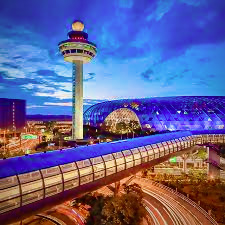 Awards.
Awards.
For Singapore’s Jewel Changi Airport has completed a 3½ year, 21,000 square-foot T2 terminal expansion which is as dazzling as it is eminently traversable. Changi’s new departure hall is an innovative balance of nature and high technology.
Its “dreamscape” features a 46-foot tall digital “Wonderfall” over megalithic boulders, along with a lush vertical garden and digital sky changing colors by the hours. These marvels join such Changi strands as an LED moonlit lake bar and luxury ‘Forest of Li Bai’ lounge. Add gourmet  dining and bushy walking trails—along with travel-themed art installations, a butterfly garden and nearly 40-foot mega-slide.
dining and bushy walking trails—along with travel-themed art installations, a butterfly garden and nearly 40-foot mega-slide.
Moreover, taking into account Changi’s transition to biometric passports and automated immigration clearance, the Singapore airport appears well equipped and prepared to serve some 95m passengers per year.
Although amid such lofty, award-winning venues and vendors, travelers may find themselves inclined to lay over awhile longer—if not move in, rather than move on to lesser airports and climes. (MTC…)
Terminal Technicalities.
(4/29/23)—Where we’re headed: prime cuts to paper cuts. Some of the questions posed below ☟ are being addressed with rapid advances in airline technology. Meaning borderline boarding crucibles and chaos—the pain points of getting through security to gates and jet bridges—are going increasingly paperless, particularly in hubs and other principal cities (notably West Coast and Asian).
The frustrations and stressors of today’s boarding bottlenecks are being somewhat ‘streamlined’ away in certain terminals by moving check-in from counters and self-serve kiosks to smartphones and 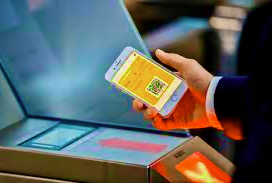 tablets. Takeoff documents and bag tags become fully screen and scanner based—mobile boarding passes issued in under a minute with bags tagging along. The goal is to rush passengers through airport lobbies in five minutes or less, speeding oversize bags, family and pet boarding, as well.
tablets. Takeoff documents and bag tags become fully screen and scanner based—mobile boarding passes issued in under a minute with bags tagging along. The goal is to rush passengers through airport lobbies in five minutes or less, speeding oversize bags, family and pet boarding, as well.
Downside? This fast-track automation is propelled by biometric data to authenticate travelers, working/sharing it with the TSA, raising security and privacy concerns across the board. Still, the ‘wired’ process handily connects passengers with carrier agents all through the pre/boarding process, while gate staff continue to serve those of us preferring standard printed-out passes on site—particularly for those leery of relying on smartphone battery life and spotty WiFi .
Add to that streaming jet bridge updates, with simultaneous front and rear cabin loading makes flight boarding quicker and simpler than ever, at least on paper. Yet it remains to be seen whether all this accelerating convenience, via glitchy high-tech complexity, proves to be a bridge too fast and far—especially up against terminal sprints and marathons across/between gates and concourses under the tight flight connection gun. By the same token, modern airport refinements in food and ambient moods alone will just not cut it with wary, weary air travelers nowadays. ☟(MTC…)![]()
Innovation=Creature Comforts?
(2/17/23)—Safety, security, expediency and delays (as in JFK’s recent three-day terminal (T-1) power outage forcing hundreds of flight ‘can/dels’, including Korean Air, ITA mid-run turnarounds—and Air New Zealand’s 16-hour abort back to Auckland): but Vamigré focuses on these issues elsewhere. So here we gauge airports and stations by developments and 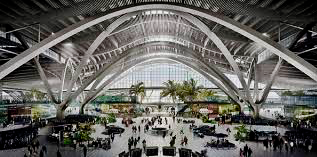 deficiencies in their accessibility, facilities, policing, increasing 2019/23 landing/parking fees. Plus shops and services (e.g., how well do they and carriers communicate to ease traveler concerns and readily answer their questions?). Let alone the vagaries and crapshoots of airport lost and founds.
deficiencies in their accessibility, facilities, policing, increasing 2019/23 landing/parking fees. Plus shops and services (e.g., how well do they and carriers communicate to ease traveler concerns and readily answer their questions?). Let alone the vagaries and crapshoots of airport lost and founds.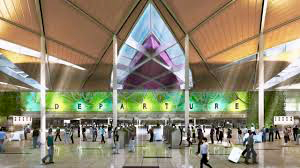
How truly comfortable are the terminals’ accommodations, particularly for those left stranded between boardings? How clear are their signage and facility information dissemination (extending to locales)? When will they renew an Airside Pass access program (such as Pittsburgh’s) which allows family and friends to see passengers off from the gate itself—if they clear TSA security—just like in pre pandemic or 9/11 days?
Are the food/dining and sundry facilities of higher grade? Do the food goodies measure up, from munchies to gourmet meals; beverages from protein smoothies to libations like pubs and wine bars—and at all costs? Beyond in-terminal comfort food/drink vendors, how soothing is the lobby/gate mood—e.g., music, from jazz and hip-hop to disco, salsa and the classics? Is there a variety of entertaining and/or enlightening diversions—from art and verdure to digital platforms or live performances?
Indeed, how plush or lacking are their basic airline clubs and VIP lounges? Are the terminals destinations in and of themselves? The comparative scrutiny and reviews will of course be trained upon railroad, bus and cruise ship terminals, as well…
Airports ’22: Peerage to Steerage.
11/23/22—Smoother takeoffs, softer landings—and everything in between. That’s what a recent Wall Street Journal survey addressed in its ranking of 50 of the largest US airports, through turbulent 2022.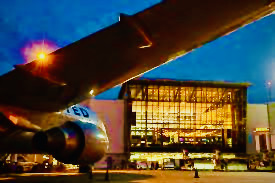
More specifically, the ‘Top 20’ are rated in some 19 categories, based upon a combo data stream from the TSA, Bureau of Transportation Statistics and airports themselves: mining from January 2021 through June ’22.
Midsize airports are similarly covered, with Sacramento International (#1) and Norman Y. Mineta San Jose International (#3) leading the way. This, as other mid and smaller airports are being increasingly abandoned by major carriers—incidentally at a time when aviation advances like electric-powered planes may sooner than later prove to be a boon to cleaner, more cost-effective little local facilities.
Terminal Stats and Status.
In any case, primarily focusing on flight cancellations and timely arrivals/departures, the WSJ study further breaks down these 20 large airports into categories by convenience, comforts and cost/value. Comparative chart columns range from facilities’ security checkpoint wait times and flight connection efficacy (e.g., inter/intra terminal distances and walk times)—to creature comforts and Yelp restaurant reviews. Also factored in is the cost of fares/fee-wise, on-site parking and vehicle rental taxes/fees.
The More the Messier.
Of that ‘Top 20’, San Francisco International (SFO) flies the highest, followed by Hartsfield-Jackson Atlanta International (ATL) and Minneapolis/St. Paul International (MSP). Stacking downward are New York’s JFK and LaGuardia, then Newark Liberty International (EWR).
San Francisco apparently bests the rest via strong on-time arrivals (82%) and departures (84%), 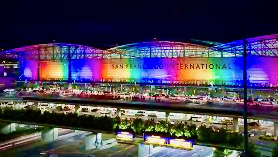 speedier automated security lanes, more efficient bag sorting and everywhere GPS. This “Quiet Airport” also features an artsy museum, yoga rooms, gourmet dining in noise-cancelled terminals, even something of a stress-relief petting zoo with rabbits and dogs.
speedier automated security lanes, more efficient bag sorting and everywhere GPS. This “Quiet Airport” also features an artsy museum, yoga rooms, gourmet dining in noise-cancelled terminals, even something of a stress-relief petting zoo with rabbits and dogs.
But this quietly transcendent, ‘beyond-the-airport’ airport experience does come at a cost—just check the fares and pricey fare amid SFO’s designer showcase renovations. Moreover in fairness, the high flyer has been operating in comparatively milder climes, serving fewer travelers (2022’s flights down 25%+ from 2019) than many other ‘Top 20’ airports—due largely to remote working and that the Bay Area (Silicon Valley included) is rather more slowly recovering from the pandemic period than other metro regions.
This past June, for instance, one major carrier (UAL) ran 6,700 flights out of SFO, while 16th ranked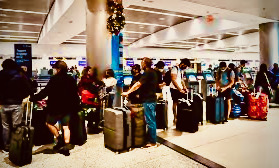 Chicago O’Hare International (ORD) flew 13,700, and 20th ranked Newark operated nearly 12,500—both dealing with more delays from volatile weather extremes at that. Function follows form and flow rates. Which is to suggest that the more flights and passengers a major airport has (over?) scheduled, the more poorly it is likely to score on WSJ’s survey.
Chicago O’Hare International (ORD) flew 13,700, and 20th ranked Newark operated nearly 12,500—both dealing with more delays from volatile weather extremes at that. Function follows form and flow rates. Which is to suggest that the more flights and passengers a major airport has (over?) scheduled, the more poorly it is likely to score on WSJ’s survey.
This evidently does influence their data-driven differences between a glowing airportraiture and comparatively dimmer, grimmer airport-a-potty. Call it growing numb to the numbers, as if shopping airports like luggage sales. In any event, it was just one Foxy news rag’s opinion—FWIW, at least for now… (MTC…)![]()
Vamoebic Airports: Growing Around the Block.
![]() Most currently, airports have expanded and perpetually continue to spread their wings, as traffic is projected to double internationally in the coming decades. For instance, Atlanta’s Hartsfield-Jackson is at the point of total gridlock; LAX satellites in
Most currently, airports have expanded and perpetually continue to spread their wings, as traffic is projected to double internationally in the coming decades. For instance, Atlanta’s Hartsfield-Jackson is at the point of total gridlock; LAX satellites in 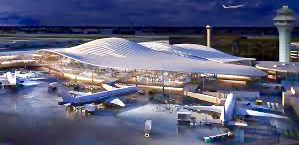 Ontario and Palmdale. Because air terminals most everywhere are more congested, passengers have been increasingly stuck in airliner cabins, particularly on the ground.
Ontario and Palmdale. Because air terminals most everywhere are more congested, passengers have been increasingly stuck in airliner cabins, particularly on the ground.
Carriers term it ‘block time’—that is, minutes, hours their planes are slogging, if not stalled on overtaxed tarmacs, overcrowded taxi- and runways, coming and going.
More travelers means more flights: consequently down and taxi time have ballooned nearly 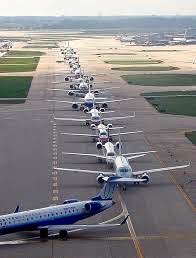 20% in the past decade at the 30 largest U.S. hubs, some 25% at medium-sized airports, Trusted Travelers or no.
20% in the past decade at the 30 largest U.S. hubs, some 25% at medium-sized airports, Trusted Travelers or no.
Since such delays are costly (operating/crew-wise) and consumer toxic, airlines tend to stow them away by padding flight times, so as to continue touting their ‘on-time’ schedules. These claims are made in the narrowest of terms under Transportation Department regulations (e.g., within 15 minutes of scheduled time; tarmac delays of three hours or less—four for international flights—weather permitting).
Still, we sit and stew—at least until tracking/rerouting technologies such as LUMO and ConnectionSaver can better suss out on-time padding and other airline scheduling (mis) calculations.
Further infrastructure/capacity growth issues include long, lateral versus circular terminals, crossing versus parallel runways, inter-concourse shuttles versus people movers; more invasive TSA screening, scanning, profiling or facial recognition; hard-driven ground transportation clotting, traffic-cop sifting through hotly competitive ride-sharing services— ‘pig pen’ staging lots to teeming terminal curbsides.
Then there is the FAA’s NextGen Air Transportation System, which utilizes GPS, rather than ![]() conventional radar, digital not radio communication. With more pinpoint air traffic control of where planes were in their respective skies, altered flight paths are tighter, lower—aircraft spaced closer together. But airports from Baltimore to Los Angeles are fielding massively more noise complaints from residents who live under or near the increasingly concentrated landing and takeoff lanes.
conventional radar, digital not radio communication. With more pinpoint air traffic control of where planes were in their respective skies, altered flight paths are tighter, lower—aircraft spaced closer together. But airports from Baltimore to Los Angeles are fielding massively more noise complaints from residents who live under or near the increasingly concentrated landing and takeoff lanes.
The Department of Transportation IG has concluded that this ostensibly fuel-saving GPS airspace system was falling short on several counts, including FAA anticipation of the aircraft noise issue, quieter new jet engines notwithstanding. Hearing such higher decibels of protestation, the aviation agency has expressed its commitment to work with airports and communities to better address “concerns about aircraft noise” between now and the NextGen system’s full implementation in 2021.
So Vamigré will listen up, touch-and-go over all of it down the conga line. Meantime, make sure the flight attendants amply souse and spice up your stew. (MTC…)
Terminal Paralysis.
Reminscent of ‘The Terminal’ motion picture, reality trumps fiction in a Malaysian airport these days, where a 36 year-old Syrian refugee, as been stranded for over 60 days , in true Tom Hanks form. Deported from the United Arab Emirates, former insurance marketing manager, Hassan Al Kontar was deported to Malaysia in 2017, landing in the Kuala Lumpur Airport. There he remains in limbo with an expired passport and loss of immigration status, with nowhere to go from there: man minus a land. 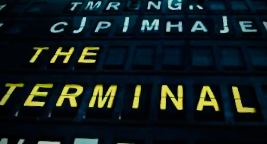
Fearing a return to war-torn Syria, where he could be recruited into Assad’s military or jailed, he cannot board flights whose intermediate stops could force him back to his homeland. Even Ecuador’s flag carrier is out, because its stopover in Turkey would refuse to take him at all—this from South American nation that has been stowing Julian Assange away for years.
So Al Kontar is stuck doing Skypecasts and posing with fellow travelers for selfies like some Jihadi abductee, ablating in the transit men’s room, and sleeping in a terminal’s stairwell. Canada offers that it can possibly help spring him, but the process could take as long as two years.
Vamigré says step up, U.N., Free Hassan! before his beard turns runway gray…
